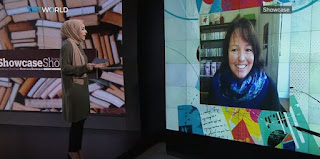One of the best things about writing historical fiction is the research – although I have to confess that I can get completely sidetracked and sometimes spend far too long researching things I know I am never going to use!
I am currently writing a novel set in mid-Victorian England and my research has brought home to me how astonishingly difficult it was for Victorian girls and women to achieve anything amid the huge obstacles which Victorian society put in their way.
All classes of Victorian men – working class, middle class and probably especially upper class - believed the old maxim ‘A Woman’s Place is in the Home’ and Victorian society did everything it could to keep them there. It took a very strong-minded woman, with talent, luck and usually some male support to break out of the mould of being a sweet, subjugated, supporter of men.
The first challenge the Victorian girl faced was that of education.
In the middle of the nineteenth century, how much education you got didn’t just depend on how much money your parents had – it also depended on whether you were a boy or a girl. Among the poorer classes, most primary-age children were educated in one of the patchwork of voluntary schools up and down the country, which provided both boys and girls with a basic education in reading, writing and arithmetic.
Drawing © Kate Randall
After the age of 11, an intelligent boy from a poor background might have been able to continue to one of the boys’ grammar schools which had grown up around the country, but there were very few options for girls. In 1864 there were only 12 public secondary schools for girls in the whole of England and Wales.But even if you were a girl from a wealthy background, you weren’t that much better off in terms of getting an education, especially compared to your brothers. In fact, you were very unlikely to have been to school at all. While boys were often sent to school at the age of 7, middle-class and upper-class girls were taught at home by their mothers. A small number might afford a governess, but this didn’t guarantee a better education as many of the governesses themselves were poorly educated.
John Ruskin was a very influential Victorian writer, art critic and philosopher.
John Ruskin
This is what he wrote in 1865 about the different ways in which men and women needed to be educated.
‘Women’s intellect is not for invention or creation…Her great function is Praise… Speaking broadly, a man ought to know any language or science he learns, thoroughly – while a woman ought to know the same language, or science, only so far as may enable her to sympathise in her husband’s pleasures, and in those of his best friends.’
The vast majority of the middle and upper classes agreed with this – women should only be educated in order to support their husbands, and certainly not to learn things for themselves! So, girls were left at home to be taught by their mothers, and if you remember that their mothers wouldn’t have been to school either, you get an idea of the sort of education they were getting. They would have learnt to read and write, and learnt a little French and a few unconnected historical facts, but you could pretty much forget anything else.
And there was another obstacle for girls. Even if your mother happened to be well-educated herself, and good at teaching, it wasn’t considered acceptable for a girl to work hard at anything intellectual. Because men’s needs always came before a woman’s needs, a girl could only carry out her studies when she wasn’t needed to fetch or carry for her father, mend her brother’s shirts, or whatever it might be. Even practising the piano seriously had to be abandoned if it disturbed someone else’s studying.
Florence Nightingale railed against this attitude in an unpublished essay she wrote on the subject: ‘How should we learn a language if we were to give it an hour a week?... [A lady] cannot leave the breakfast-table – or she must be fulfilling some little frivolous ‘duty’...If a man were to follow up his profession or occupation at odd times, how would be do it?...It is acknowledged by women themselves that they are inferior in every occupation to men. Is it wonderful? They do everything at ‘odd times’…’
Luckily, there were strong-minded, intelligent women who fought against this prevailing attitude. Some women defied convention and learned as much as they could from books and any male relation who was happy to teach them. Others were able to take advantage of the institutions which were gradually set up as the century progressed. (By the way, in 1868 a government commission admitted that men and women had the same mental capacity!)
Florence Nightingale
As we all know, Florence Nightingale herself blazed the trail for the nursing profession, setting up the first nursing school at St Thomas’s Hospital in London in 1860, where crucially nurses would be trained. In 1848, Queen’s College in London was founded to educate governesses. Among its students were two women, Dorothea Beale and Frances Buss, who went on to become pioneers of girls’ education: Dorothea Beale became Principal of Cheltenham Ladies’ College and Frances Buss was Headmistress of the North London Collegiate School.
Frances Buss
Before researching my current novel, I had sometimes looked at a list of so-called ‘Great Victorians’ and wondered why there weren’t more women on the list. I think I know now. Women had to overcome so many more obstacles than men before they could even start ‘achieving’ anything at all!
Catherine Randall’s debut novel The White Phoenix is set in London 1666, and features a strong girl breaking out of the mould society tries to force her into. It was shortlisted for the Historical Association Young Quills Award 2021.






































